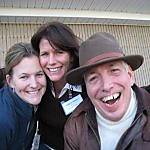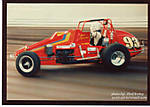You are viewing the archived version of the site.
Go to modelshipwrights.com for the current dynamic site!
Go to modelshipwrights.com for the current dynamic site!
1⁄72Airfix 1:72 Vosper “Type I” MTB Conversion
6
Comments
Rebuilding the Airfix 1:72 Vosper “Type I” MTB as MTB-385
Model Originally Built By and Rebuilt By: Stan Pienkowski
Model Owned By: T. Garth Connelly
Article By: T. Garth Connelly and Stan Pienkowski
Photos By: Tom Connelly
History
In 1997, under the auspices of doing research for a second In Action series book on British Vosper Motor Torpedo Boats, my older brother went with me to England. My brother went with me because I am physically disabled. I did a considerable amount of research that first trip. I also was able to do some sightseeing as well. On a trip to the Royal Navy’s Dockyard in Portsmouth, to see the H.M.S Victory, I saw a sixty-foot Vosper Motor Torpedo Boat that was awaiting restoration.When I was in High School, in the mid-seventies, my father bought me a model of a British torpedo boat, the 1/72nd scale Airfix kit of the seventy three foot Vosper Motor Torpedo Boat. He even built it for me, but he just painted the bottom black and did not put on any decals. Somehow, the model ended up in our basement and in 1978, when our basement was flooded, that model as well as some of my unbuilt kits, was thrown out.
I never gave any thought of replacing the model because at that time, my father did not have any free time to build models anymore, nor did my brother. At that time as I was writing the text of the book on the Vospers, I thought since I had written a book on American PT boats in 1994, and by 1996, I had several models of three types of PT boats, it might be a good idea to have a model of a British Motor Torpedo Boat. The way I looked (look) at it is; if Clive Cussler can have a model of each ship/wreck that he writes a novel about, I can do the same!
One day, after we returned from England, my brother was in a local hobby shop with our nephew (who accompanied us on each of three of the seven trips we made to England) and they saw an old Airfix kit of a Vosper seventy three foot MTB on a "dollar table." So, they picked it up for me. By that time, I had met Stan Pienkowski and I knew it would be built and done completely.
The Type
This model depicts a unit of the Vosper Type I. The boats of this type were built from 1943 onward. The type was armed with four eighteen-inch torpedoes, a twin 20mm Oerlikon and optional single .50 caliber machine guns or two single two inch rocket flare projectors mounted on the forward tubes and twin .303 inch Vickers guns mounted on the after tubes. They were powered by three Packard engines that were supercharged, each producing 1,400b.h.p, which gave the boats a maximum speed of 39.9 knots. At a speed of 20 knots, they had an operational range of four hundred seventy miles. All of the Type Is and the follow-on Type IIs were operated in home waters.The model, which my brother bought for me, was one of the ones from the mid-1970s, like the one my father had gotten me while I was in high school. It even had the same box art. The kit itself has a good, general outline and it does seem to match the pictures that I have seen of that type, but, I am quite sure that a skilled scale modeler would be able to pick out flaws in it.
Also, remember, today we also have after-market accessories that help us make a kit more detailed. So, even a mediocre kit from the 1960s, like Revell’s Fletcher Class Destroyer could be transformed into a good-looking model with a little imagination and work. So, therefore, ergo and to wit, if there are flaws in the Airfix Vosper MTB kit, they can be remedied by either scratchbuilding new parts or by using after-market accessories.
Construction
My Vosper was built straight from the box, which, ever since I have become acquainted with Stan Pienkowski, is a rarity. That was because of two reasons. One, because at that time I had just gotten to know Stan, and I did not want to be an imposition on him by making too many demands. Two, again, at that time, I did not know much about British MTBs. This lack of knowledge would come to haunt me when it became time to paint the model. But, as I have come to know Stan, I have also come to realize that he actually enjoys super-detailing a model perhaps more than I do. This is fine by me.The only break from the straight-from-the-box description of this modeling project was the fact that I did not have Stan put the bottom of the hull on. I had decided to have him make it as a waterline model. This was because I have never had a water-line model and they always had intrigued me. This project would therefore be an experiment for me. As it turned out, Mr. Pienkowski proved to be quite adept at creating water.
If, at that time, I knew more about Vosper MTBs than I do now, I would have bought (and/or scrounged) better guns than the kit’s two single Browning .50 caliber machine guns and the twin 20mm Oerlikon gun. One could also replace the two twin .303 caliber machine guns, though the .303s are really quite good.
The Water
Stan created the water by using a piece of Sheetrock, covering it with Spackle to simulate the wave action of the water. He used the now discarded bottom of the hull to stand in as an outline of the boat to form where the boat would be placed. After that, he spray-painted the water with dark blue paint and green paint and dry brushed white paint over that to create wave tops.The Paint Scheme
The boat was painted as per the instruction sheet because, at that time, I did not know much about MTBs. If I had, I would have caught an error. As it was a rather big and glaring error. The colors of the scheme in the kit’s instructions were reversed. What was supposed to be a light gray was instructed to be dark gray and what was supposed to be a dark gray was supposed to be painted light gray instead of the other way around. I did not know that! I did not catch that until I was doing the layout for my book on Vosper MTBs two years later. Oh well. The noted British naval historian, H. John Lambert (“Sir John” to me) came for a visit in the early 2000s and he didn’t notice the error, but still, it bothered me greatly.It was always in the back of my mind, that one day; I’d have the model corrected. It’d be either done by Stan or whomever else I could ask. But, it was never a top priority. One day, one of my Siamese cats was sitting on top of the model’s case and my brother shooed him off and as he was getting traction, somehow, his back-feet propelled the case off of the shelf and onto to the floor. Only a few pieces were knocked off and the rigging was loosened, but other than that, it was intact.
It was, at least to me, enough damage to warrant a rebuild, with better armament, an accurate paint job for MTB-385, replacing the thread rigging and ‘new’ hull numbers. I arranged with my brother to have it taken over to Stan’s house. But, before ‘we’ could get it over to Stan, our father was diagnosed with terminal cancer, from which he has died from in October 2009. So, from May of 2008 until this past October, he was the focus of my brother’s time.
So, understandably, ‘unimportant’ projects (like modeling projects) were put on hold. So, in the mean time, I gathered what materials Stan would need to use to re-do this model. This included new hull numbers, two twin .303 guns and an Holman Projector from Great Little Ships from England, a resin twin 20mm Oerlikon gun and a single .50 caliber machine gun from Nautilus Models.
The numbers came from a modeler named Bill Luther. Soon after my father passed away, aspects of our lives slowly returned to normal. So, one day, my brother took my Vosper over to Stan’s house. He took the model in its case, the resin guns that I had gotten from Nautilus Models and the excellent parts from Great Little Ships, the decals and a slew of written instructions from me to Stan. The first thing Stan did, was to make sure that he had all of the lose pieces that had fallen off when the model crashed on to the floor. Next, he made sure that he knew where they all went and reinstalled them. He then took out the replacement guns to make sure he had the right ones for the right place.
He made up the new guns before, he removed the old, and painted them gunmetal. Stan then removed the two rear stanchions because they were broken off and installed new ones. Also, he made a new flagpole. He made a drawing of the rigging, took the rigging off until last. In order to repaint the model, he had to remove the hull from its base. Once he had removed everything which was being replaced, he painted the hull with a first light gray coat on the entire boat. The second coat was airbrushed on. He then hand painted the deck and side. Stan also made a new thinner wind-shield to replace the kit’s original thick and chunky one. He used thinner clear plastic to do this.
Now, remember, originally the model was painted incorrectly. It was supposed to be painted in a scheme which the Royal Navy designated the “Light Standard F Scheme”. This scheme is described as this: "Scheme F is the basic design for coastal force craft and is for use on all foreign stations. All vertical surfaces and side are painted color G.45 except those in shadow which are painted White, and horizontal surfaces are painted color B.15.
However, for some reason, when Stan originally painted the model, as per the kit’s instructions … what was supposed to be in a dark gray was painted a light gray and what was supposed to be in a light gray was painted a dark gray. I did not catch the error until years after. For the darker gray, Stan used a color named “Aggressor Gray”, for the lighter gray, he used something named “Light Gray” and for the gray on the deck, he used something called “Euro Gray.” These sound like they are paints which one would use on a modern-era jet either from the US or NATO, but I have to say this; these three colors are close matches to naval paints that one would find in White Ensign Models’ ColourCoats line of paints. For the guns and the Holman Projector, he used a paint named “Gun Metal”, it is a perfect match to the color of the weapons.
He then sealed the model with dull coat. After that, he re-installed the guns and rigging and reinstalled the boat on the base. He did try to use clear fishing line for the rigging but, he could not get any of the gluing agents to work attaching the line to the model, so, he used a thinner thread than he originally used in 1998. Stan then touched up whatever needed to be touched up and the model was finished.
Conclusion
I must say that this rebuilding project actually improved the appearance of this old model. The new, more accurate paint scheme, which closely resembles the one worn by the real H.M. MTB-385 actually ‘makes’ the model. As do the resin twin 20mm Oerlikon gun and the Browning M2 .50 caliber machine gun from Nautilus Models and the white metal Holman Projector and the two twin .303 Lewis guns from Great Little Ships.I will admit that, the .303 caliber Lewis guns which the real 385 was fitted with did not have the ‘jacketed’ barrels, but I actually like the look of the ‘jacketed’ guns better. That’s the only inaccuracy on this model. I am extremely pleased with the outcome of this ‘dry-docking’.
Comments
Thanks Kenny,
Yeah, it really came out of "drydock" a lot better than it went into it. The new CORRECT paint scheme really dresses it up as does the guns from NAUTILUS and GLS - the Holman Projector from GLS adds another historical accuracy to it too.
Wait until you guys see the MGB that I'm having built from the AIRFIX RAF ASRL ... Mr. Pienkowski is using a 20mm from WEM, as well as their Colourcoats paints, Vickers 0.5 inch guns from AEROCLUB and depth charges from GLS on that bad-boy ...
Garth
MAY 16, 2010 - 02:47 AM
Nice job! Do you think if I get a hat like yours that I could attract nice looking women like in your photo?
MAY 16, 2010 - 10:43 AM
I dunno Bob, you Salami ...
That's my Indiana Jones hat and jacket.
Oh, and get this; they're sisters.....................
MAY 17, 2010 - 02:26 AM
Very nice build Garth! Great little story and build information. Thanks for sharing!
MAY 19, 2010 - 01:18 AM
Thanks James, it has become one of my favorite models since the rebuilding.
If one has the skill, time and good research data and good after-market accessories - the kit CAN be made into a stunning model.
Garth
MAY 19, 2010 - 05:34 AM
Copyright ©2021 by T. Garth Connelly. _OPINIONS Model Shipwrights, KitMaker Network, or Silver Star Enterrpises. Images also by copyright holder unless otherwise noted. Opinions expressed are those of the author(s) and not necessarily those of Model Shipwrights. All rights reserved. Originally published on: 2010-05-15 00:00:00. Unique Reads: 20039





















